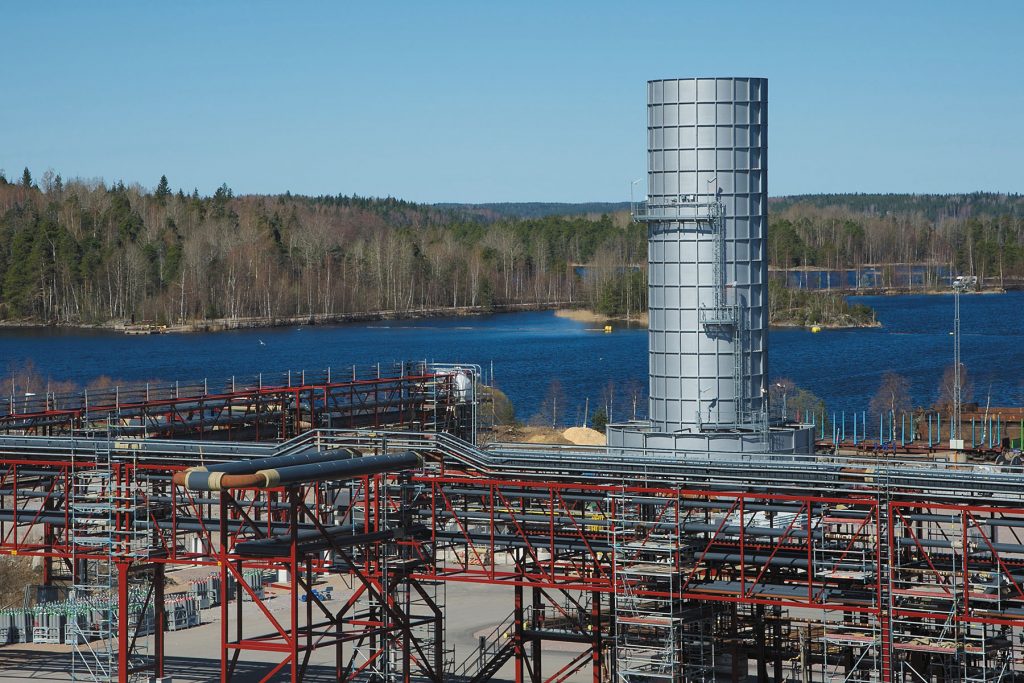MARK RUSHTON
The pulp and paper industry in Europe has shown real resilience in the face of challenges presented by COVID-19 and has been instrumental in keeping things going as normally as possible by supplying essential hygiene and packaging products. Jori Ringman, director general at Cepi, says “We reported early on in the pandemic to the European Commission. In fact, in March, 2020, we highlighted the fact that there were huge risks when it came to transport disruption, particularly for essentials such as hygiene and packaging for food and pharmaceuticals. They listened to us and subsequently asked all industry sectors to report in a similar, uniform way.
“This actually meant Cepi became a catalyst for the EU’s development of a masterful plan for a ‘green lane’ for essential goods, so that even when people were stopped from travelling, goods could still freely flow.”

Bernard Lombard, trade and industrial policy director, Cepi, adds “It’s difficult to get an exact figure on the effects of the pandemic on production as there are a lot of things going on at the same time, including Brexit. Reports indicate that paper and board production is down by about 5-6 percent. However, this is mostly due to graphic papers’ decline by around 20-25 percent, which has been accelerated by the pandemic.
“The safety of employees has been one of the major factors we have been involved in since the emergence of the virus. National paper associations and companies have been heavily involved in dialogue with unions in an effort to adopt the safest working practices. All in all, we have learned a lot across the industry from the pandemic, and particularly it has highlighted that there is an essential need for the products from our industry, whether it be hygiene or packaging products.”
ANOTHER MAJOR CHALLENGE
Away from the challenges of COVID-19, the industry has another major challenge in front of it in the shape of the European Green Deal, which plans to be net-neutral in the emissions of greenhouse gases in Europe by 2050. “The European industry has done a fantastic job over the last 15 years; in fact, we have been the best-performing industry sector in reducing CO2 emissions. We have actually reduced CO2 emissions since 2005 by 28 percent, and reduced energy consumption by 12.3 percent; it’s an amazing track record. But now politicians have told us that by 2030—just around the corner—the EU economy as a whole has to reduce CO2 emissions by 55 percent,” says Ringman.
“It is quite interesting to note that being the leading sector in all these reductions hasn’t really helped our cause,” he says, “because we have worked so hard and been so successful, we are seen as the ‘good student in the class,’ so now we don’t get the attention we deserve anymore!”
The upshot of this is that other, less well-performing sectors—the “bad students in the class”—are getting a lot more attention when it comes to help from the EU and particularly when it comes to funding.
“If we managed to reduce CO2 emissions by 28 percent in 15 years, in the next 10 years we have to reduce it even more than that, which is going to be hard. We need to have a lot of breakthrough technologies and innovation to do this, as well as funding to achieve that high target.
“This means we have to shout even louder and stronger when it comes to getting our voice heard,” Ringman adds.
Cepi has a well-defined history of not running away from challenges, and instead is constantly looking for new and innovative ways to help its members and associations adhere to policy while weathering market storms. This it does by finding new, innovative ways of approaching the future and, in particular, currently reducing the pulp and paper industries’ carbon footprint in every way possible. This it does by carrying out in-depth studies and creating new initiatives that get to the heart of both the pulp and paper industries, seeking out and devising ways where more and more progress can be made in alleviating climate change.
FIBER-BASED PACKAGING CIRCULARITY
One of Cepi’s latest initiatives in the drive for carbon neutrality is 4evergreen, a cross-industry alliance aimed at boosting the contribution of fiber-based packaging to the circular bioeconomy across the value chain. The alliance’s vision is to “perfect the circularity of fiber-based packaging to contribute to a climate neutral and sustainable society.” Already proving popular with major consumer brands, the alliance counts 60 active members across the fiber-based packaging value chain, including leading brand owners like Nestlé, Mars, P&G, Danone, IKEA, Kellogg’s, and Ferrero.
“There is more than one way to deal with climate change as an industry,” says Ringman. “Yes, reducing our own carbon footprint in manufacturing is of major importance, but so is the increased use of our products, which avoid emissions through the ‘substitution effect.’ Our packaging products are the absolute classic example of a real life working circular economy: material made from renewable fibers, then recycled to make raw material for yet more products.”
According to consultants McKinsey—hired to form the baseline for the 4evergreen alliance and create an understanding of exactly how the recycling of packaging is performing in the circular economy—fiber-based packaging accounts for 38 percent of the total packaging market, with around 80 percent of the packaging used being recycled. The aim is to increase that to 90 percent and full circularity by 2030.
“With the 4evergreen alliance, we have formed an initiative with many bright minds involved from across the whole spectrum of the industry from forest to brand owner. Each will have a view and an opinion on how things work and can be improved across the whole process. This difference in perspective is already shining a whole new light on how circularity can be perfected and turned further into a closed loop,” says Ringman.
“The substitution effect has enormous potential when it comes to fiber-based packaging: it is estimated that 4 million metric tons of packaging currently derived from fossil material can be immediately replaced by fiber-based packaging. This is another big step in the way the European industry can contribute to carbon neutrality.”
NEW BIOREFINERIES STUDY
FOR EUROPE
There has been a lot of talk industry-wide about the opportunities presented for the creation and production of bio-based products at mills other than pulp and paper products. These are products that can be made, for instance, out of waste streams or side streams at pulp and paper mills, subjects that are gaining more and more interest among producers seeking extra revenue and added value creation.
So far there have not been any studies on any continent identifying such biorefineries making bio-based products specifically based on wood as a feed stock. Early last year, Cepi commissioned NC Partnering, a Finland-based consultancy, to conduct a study to identify these biorefineries across Europe. The result is a comprehensive report entitled: “Innovative Bio-based Products for a Sustainable Future: A Cepi Study on Pulp and Paper Biorefineries In Europe.”
“This was a difficult but rewarding task,” says Lombard. “We first needed to agree on a methodology so that we were all on the same page, and then come up with what the definition of a biorefinery actually is.”
For the report, Cepi defines a biorefinery as the “concept of a processing plant where forest-based feedstock is converted and extracted into a spectrum of value-added products.” The biorefineries were then classified into three categories:
• Category 1: Biorefineries based on chemical pulping operations to produce various existing or emerging bio-based products
• Category 2: Biorefineries using virgin pulp and /or recycled fibers to produce emerging bio-based products
• Category 3: Other biorefineries using lignocellulose as a raw material to produce various existing or emerging bio-based products.
In all cases, the feedstocks of the biorefineries are of primary forest origin (wood). Bioproducts are classified as materials, chemicals, fuels, food/feed, pharmaceuticals, and cosmetics and can be for both commercial and internal use. The study identified 139 biorefineries across Europe, mostly based in chemical pulping, with the largest numbers being situated in Sweden, Finland, Germany, France, and Austria.
The study also found that the current value of new bio-based products is around Euro 2.7 billion (US$3.25 billion). This represents about 3 percent of the total value of the industrial production of European pulp and paper mills and is a rapidly growing area.
The study reports that the largest share of bio-based products is related to materials—in particular, that of man-made fibers for the textile industry. As the global textile market demand is around 100 million mtpy, with only 6 percent being based on man-made cellulosic fibers, this represents a huge opportunity for pulp mills to further enter the textile market with dissolving pulp or other alternatives to fossil-based fibers.
Other common bio-products identified are biodiesel, lignosulphonate, and tall oil products.
“The findings of the study were really interesting,” says Lombard. “And it is quite amazing to look at the different classifications of products that the industry is beginning to produce, including chemicals, fuel, food, cosmetics, and pharmaceuticals. We see this area substantially increasing in the future and will not only go toward meeting the European Green deal ambitions for a carbon neutral continent by 2050, but very importantly will help the industry to develop, grow, and add value into the future.”
Mark Rushton is senior editor for Paper360° and editor of Tissue360°; reach him at [email protected]. More information on the 4evergreen initiative and the biorefinery study, including a downloadable executive report, can be found at Cepi: cepi.org.
 Paper 360
Paper 360

